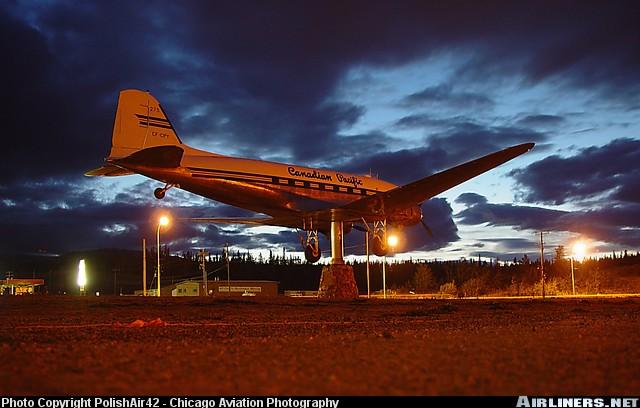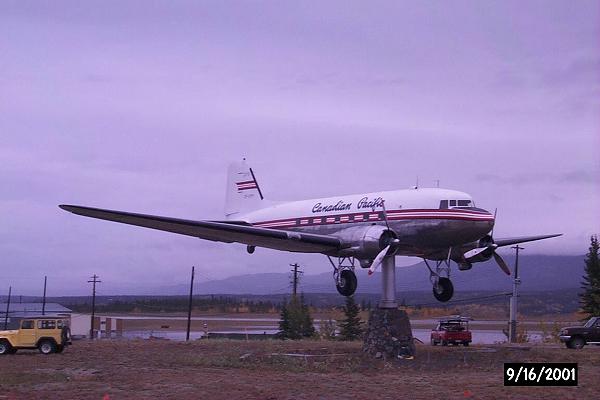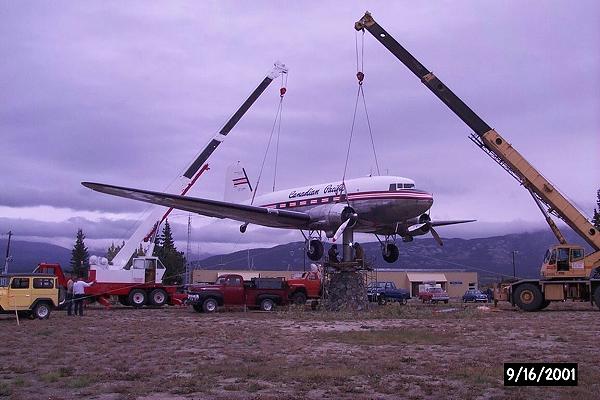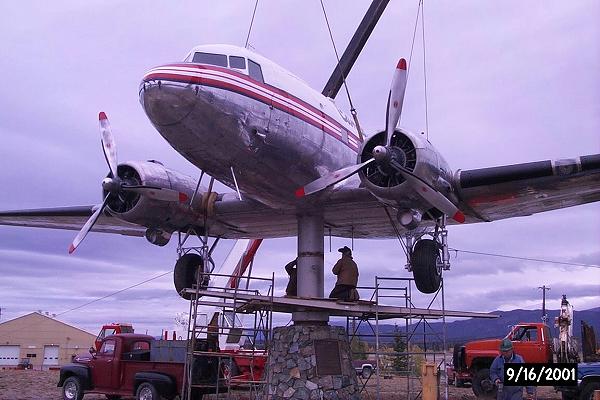

Photo by Ralph Kunadt

By D. Davidge, and Jim Mcfadyen
Built in August of 1942, DOUGLAS, Serial No.4665, spent the first three years of it's life in the camouflage war colours of the U.S.A.A.F., flying transport missions in India and China.
At the end of the war it, along with several other C-47's, was sold by the War Assets Corporation to Grant McConachie's newly formed Canadian Pacific Airlines. Converted to the civilian DC-3 configuration in 1946 and issued the Canadian registration of CF-CPY, she began her fifteen year career with C.P.A., flying the company's scheduled routes throughout Canada. These were flights that you could buy airline ticktets for.
During the mid fifties, as C.P.A. upgraded their mainliners to Convairs and DC-6B's, CF-CPY soon found herself serving the less glamourous domestic routes, including, the Whitehorse-Mayo-Dawson run.
In 1960 the airplane was sold to Connely Dawson Airways of Dawson City. For the next six years she worked as a bush plane, operating on wheels or skiis, hauling supplies north into remote places like Old Crow and the early oil exploration camps in Eagle Plains.
From 1966 until her last flight in November 1970, CF-CPY was again based in Whitehorse, serving the Yukon charter and scheduled routes of Great Northern Airways.
Although her total flying time of 31,581 hours is not unusually high for a DC-3, in the case of CF-CPY most of that time has been logged either in the Yukon or flying routes connecting the Yukon with the outside.
In 1977 the Yukon Flying Club undertook the task of restoring this northern veteran to it's original Canadian Pacific Airline colours for permanent display at the Whitehorse Airport. Pivoting on it's mount, the aircraft always points into the wind, the Yukon Flying Club is indebted to many local businesses as well as several Government Departments for their invaluable contributions to the project.

For any of you traveling the Alaska highway during 1999, you would not have seen CF-CPY, only her pedistal and plaque. The plane has been taken down for a much needed paint job and brought to the transportation museum's hanger, a few hundred yards to the south. The work is being done by volnteers, I am also one of the volenteers working on CF-CPY. When I learn more I will add it to the page, funding, whatever. When I started putting in time, the paint had already been removed. My first night on the plane, I was put on the rear wings. I was to apply an acid solution to the surface and scrub the area with a 3M Scotchbrite pad and rinse in about 5 minutes.

CF-CPY DC-3 Restoration - UPDATE TO date (March 23rd) approximately 275 hours of volunteer time has gone into removing the aircraft from the pedestal, removing the wings and transporting the aircraft to the Yukon Transportation Museum Hanger, stripping the old paint off and preparing the aluminium skin for a new paint job. To date approximately $16,000.00 has been expended on fabric covering the flying surfaces and purchasing supplies. The paint has been donated by Canadian Airlines International.

Since January, 2000 a compliment of about 15 volunteers have been busy removing the last of the old paint, preparing the painted surfaces and polishing aluminium. Hopefully by early April, we will be ready for painting. Once this is done the last of the polishing can take place and then we are into the home stretch. Although we are still many hours away from putting CPY back on the pedestal, we anticipate completion early this summer.
Additonal photo's by D. Davidge and Jim Mcfadyen


Celebrated weather vane (CF-CPY) hoisted to pedestal
by CHUCK TOBIN - Whitehorse Star - 16th September 2001
The DC-3 weather vane is airborne again.
After three years, hundreds upon hundreds of hours of volunteer labour and
thousands of dollars in expenses, the unusual landmark that's turned many a
head was hoisted back onto its pedestal Sunday afternoon.
What's referred to as the largest weather vane in the world was originally
restored in 1977 and mounted in 1981.
It was taken down in July 1998 by the Yukon Transportation Museum, in order
to address years of exposure to the outdoor elements.
"The weather will take its toll, and the sun, but we used the best kind of
paint we could for that type of operation, so I think it will do for at
least a couple of decades," volunteer worker Doug Davidge said in an
interview this morning. Davidge said a core group of 10 who've worked on
the project since the beginning -himself included -were joined in the last
six months by several more volunteers for the final push.
But it wasn't decided until Friday night at a regular work session for the
volunteers that they'd attempt to re-erect the DC-3 this weekend, given
that weather conditions were expected to be mostly favourable, particularly
the forecast for little wind.
"If we would have had high winds, I am sure it would been very difficult,
and a little bit dangerous," Davidge said.
"Over the two days, I think everything went as smoothly as everybody could
ask for."
Davidge said the fuselage and wings were removed from the restoration shed
next .to the main museum and taken to the pedestal in front of the
Whitehorse International Airport on Saturday, where they were reassembled
in preparation for the arrival of two cranes Sunday.
For about three hours yesterday, beginning when the cranes arrived at 11
:30 a.m., the volunteers worked to finish off a project that began in the
museum's board room, back when Davidge and other board members didn't know
if it was best to refurbish the aircraft where it was or take it down.
"I felt excellent," he said, of watching the DC-3 returned to its
pedestal.
"It was a long, long process to take it from
where it was to where it is now. I don't think anybody had any idea it was
going to take this long."
The faded and peeling colours of recent years have been replaced with a
vibrance. It now boasts a brilliant white, black and red colour scheme of
CP Air - 1950s vintage - including a hand-polished finish, from nose to
tail.
It was first covered in a camouflage pattern, when it was used in India and
China to fly transport missions in the Second World War.
The aircraft was sold to Canadian Pacific Airlines, then changed hands
among a number of Yukon-based airline companies, until it was finally
donated to the Yukon Flying Club in the 1970s.
In an interview in mid-August, as restoration work was nearing its end,
Davidge estimated the cost to date was $15,000 to $20,000.
This morning, he said the final price tag isn't known yet, but he doesn't
expect there's been a lot more cost added on. And the volunteer-meter is
probably some l,500 hours, including this past weekend, he said.
Davidge said final statistics and costs will be put together in the next
couple of weeks, so that when the world's largest weather vane needs its
plume groomed again, the crew will know what to expect.
Will he be involved next time?
There are still those around who worked on the first restoration project,
and did assist and provide some advice this time around, Davidge pointed
out.
But, as he hinted, it's one of those projects you do once, and when it
comes around again, it's somebody else's turn. Davidge said the museum is
planning to have a ceremony soon to mark the completion of restoration.

After 3 years of restoration, the DC-3 CF-CPY is again back on
display in
the Yukon. On September 16, 2001, work crews erected the aircraft
back onto
the original pedestal at the Whitehorse International Airport. The
aircraft
was restored to 1960s Canadian Pacific colors and is once again "turning in
the wind" on the pivoting pedestal. Approximately 1500 hours of
volunteer
time was needed to complete the job. Attached are a few photos from
yesterday (photos by D. Davidge).

Aircraft History
Built in August of 1942, DOUGLAS, Serial No.4665, spent the first
three years of it's life in the camouflage war colours of the U.S.A.A.F.,
flying transport missions in India and China.
At the end of the war it, along with several other
C-47's, was sold
by the War Assets Corporation to Grant McConachie's newly formed Canadian
Pacific Airlines. Converted to the civilian DC-3 configuration in 1946
and issued the Canadian registration of CF-CPY, she began her fifteen
year career with C.P.A., flying the company's scheduled routes throughout
Canada. During the mid fifties, as C.P.A. upgraded their mainliners to
Convairs and DC-6B's, CF-CPY soon found herself serving the less
glamorous domestic routes, including, the Whitehorse-Mayo-Dawson run.
In 1960 the airplane was sold to Connely Dawson Airways
of Dawson
City. For the next six years she worked as a bush plane, operating on
wheels or skiis, hauling supplies north into remote places like Old Crow
and the early oil exploration camps in Eagle Plains.
From 1966 until her last flight in November 1970, CF-CPY
was again
based in Whitehorse, serving the Yukon charter and scheduled routes of
Great Northern Airways.
Although her total flying time of 31,581 hours is not
unusually high
for a DC-3, in the case of CF-CPY most of that time has been logged either
in the Yukon or flying routes connecting the Yukon with the outside.
In 1977 the Yukon Flying Club undertook the task of
restoring this
northern veteran to it's original Canadian Pacific Airline colours for
permanent display at the Whitehorse Airport. Pivoting on it's mount, the
aircraft always points into the wind, the Yukon Flying Club is indebted to
many local businesses as well as several Government Departments for their
invaluable contributions to the project.
In 1998, after nearly 18 years on the pedestal, the plane was removed for a
2nd restoration. Three years and almost 1500 hours of volunteer time
later,
CF-CPY is again back up "turning in the wind" on it's unique pivoting
pedestal.
The aircraft was installed back on the original pedestal on September 16,
2001.
Doug Davidge
